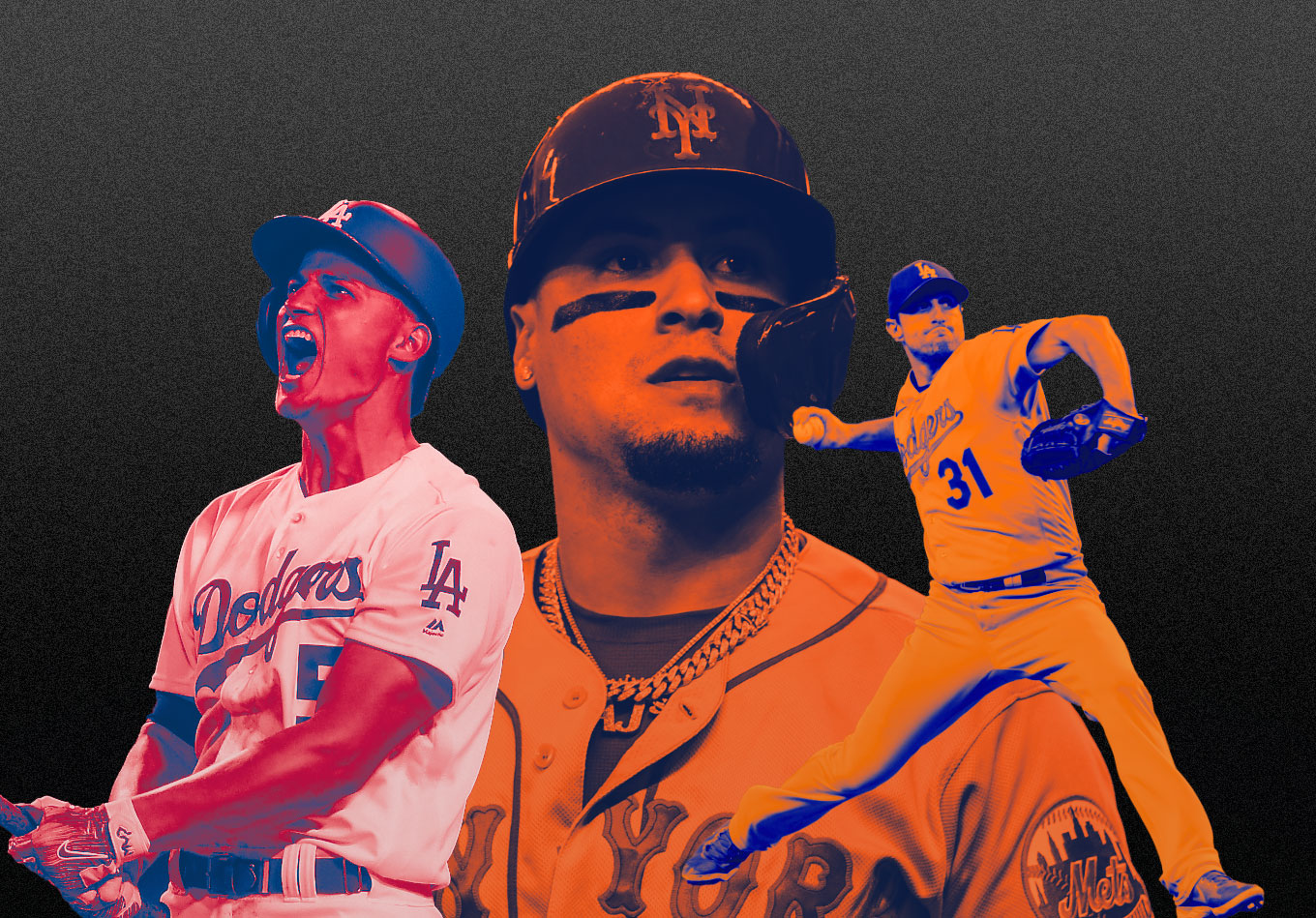The Texas Rangers were big spenders this offseason before everything came to a halt. By paying out the most money in free agency (so far), they’ve guaranteed themselves major improvement in 2022. Or have they? We aimed to find out.
It was the storm before the calm.
The early December deadline for the players and owners to reach a new collective bargaining agreement acted as something of a signing deadline as well, with a record $1.7 billion committed to free agents in the month of November.
The Texas Rangers led the way with a massive $561 million spending spree, inking former Los Angeles Dodgers shortstop Corey Seager to a 10-year, $325 million megadeal and ex-Toronto Blue Jays slugger Marcus Semien to a seven-year, $175 million contract.
Seager finished 23rd in the majors during the regular season with a 144 raw value+ among those with at least 400 plate appearances. Raw value+ (RV+) assigns value to all the different outcomes of each pitch – a batter’s discipline, contact and damage inflicted on a batted ball – instead of waiting for the conclusion of the at-bat.
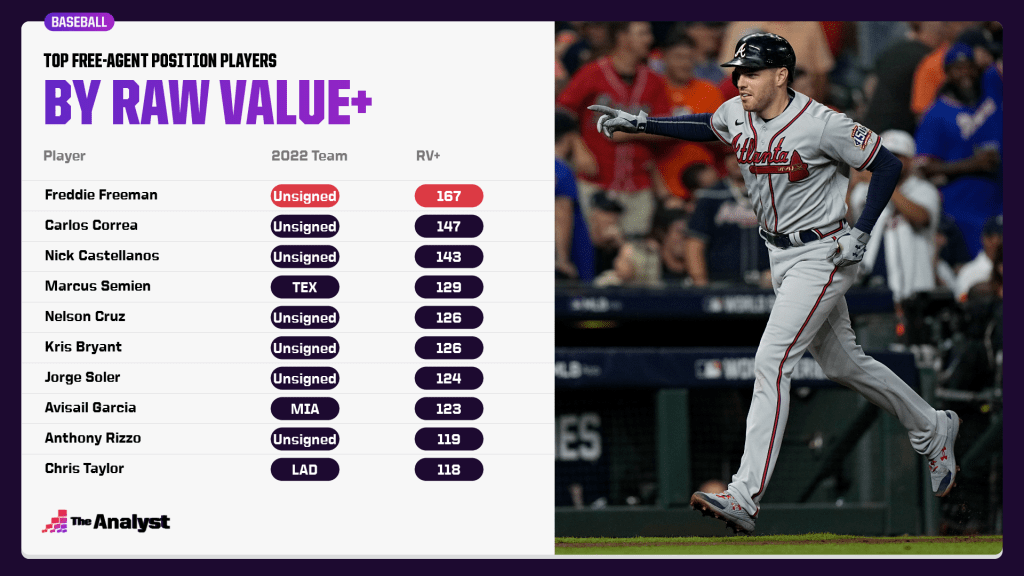
Semien hit 45 home runs to set a record for a second baseman while finishing 11th in MLB with a 121 discipline+, which in simplest terms, measures a batter’s ability to swing at strikes and lay off pitches outside of the zone.
After they went 68-61 from May 8 on last season, the Detroit Tigers looked to build on that performance by signing two-time All-Star shortstop Javier Baez for six years and $140 million, and left-hander Eduardo Rodriguez to a five-year, $77 million deal. Likewise, the Seattle Mariners picked up AL Cy Young winner Robbie Ray on a five-year, $115 million contract after just missing out on the postseason in 2021.
The New York Mets have designs on bouncing back from their disappointing 77-85 campaign as they inked ace Max Scherzer (three years, $130 million) and outfielder Starling Marte (four years, $78 million) to big contracts.
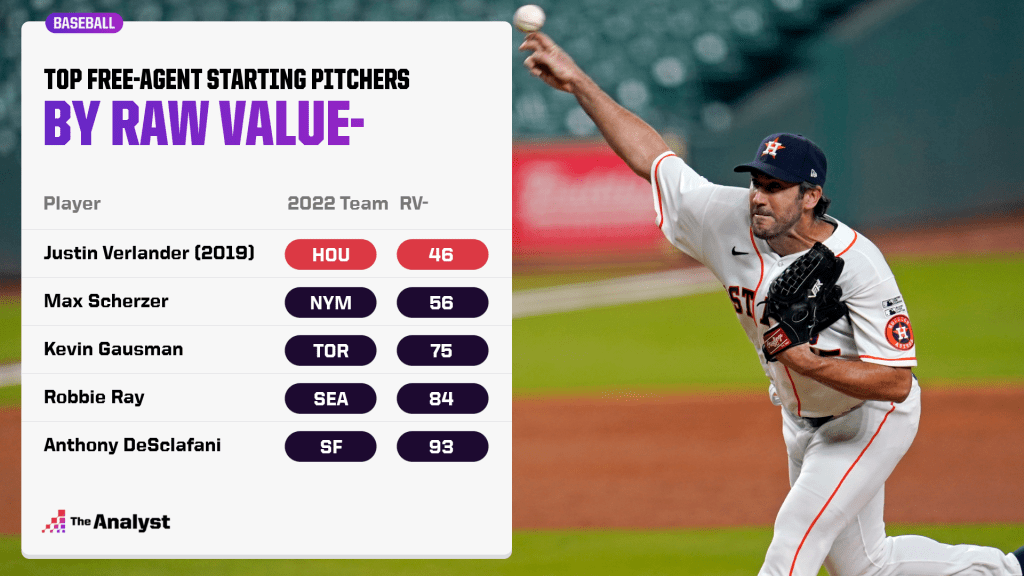
When the clock quite literally struck midnight, it marked the end of what some called one of the most exciting offseason periods of all time. But what does it all mean? At the time everything stopped, the Rangers and Mets ($254.5 million) were the highest spenders off the offseason.
How often has that translated into a deep postseason run? How often has it made a team more likely to reach the playoffs? Or does it more usually just lead to an improvement in wins the following season?
We’re attempting to answer that question by looking at the top-spending teams of each offseason over the past nine years and comparing how they performed before and after their shopping sprees.
Note: We’re not including blockbuster trades but rather only spending on free agents (using spotrac.com). Additionally, we acknowledge that injuries may have played a role in a team’s performance from season to season.
2020-21: Toronto Blue Jays
2020: 32-28, qualified for expanded playoffs and lost to the Tampa Bay Rays 2-0 in the AL Wild-Card Series.
Offseason: The Blue Jays ($186.25 million) spent the most money in the 2020-21 offseason, outspending the Philadelphia Phillies (161.8) and even the Los Angeles Dodgers (158.75) and New York Yankees (114.45). They stole George Springer, who ranked 27th in the majors with a RV+ of 141 in 2020, away from the Houston Astros on a six-year, $150 million deal and took a chance on Semien on a one-year, $18 million contract after he struggled to a RV+ of 65 and a BIP+ of 39. While Springer battled injuries for most of the season, Semien rose to stardom and earned a huge deal with the Rangers.
2021: 91-71, 9.0 games back in the AL East and 1.0 out of a wild-card berth.
Return on investment (ROI): Better but short of the postseason.
2019-20: New York Yankees
2019: Yankees – 103-59, won AL East and lost to the Astros 4-2 in the ALCS.
Offseason: The Yankees (336.5 million) and Washington Nationals were easily the biggest spenders of the 2019-20 offseason, though much of the Nationals’ spending was re-upping with Stephen Strasburg (seven years, $245 million). New York signed Gerrit Cole, who had led the majors with an RV- of 40 in 2019, away from the AL champion Astros on a nine-year, $324 million contract that stole the headlines. The ace right-hander was third in the majors in whiff+ (143), 10th in RV- (62) and had a 2.84 ERA in 12 starts for the Yankees during the 60-game 2020 season.
2020: 33-27, qualified for the postseason and lost 3-2 to the Rays in the ALDS.
ROI: Worse.
2018-19: Philadelphia Phillies and San Diego Padres
2018: Phillies – 80-82, 10.0 games back in the NL East and 10.5 out of a wild-card berth.
Padres – 66-96, 25.5 games back in the NL West and 24.5 out of a wild-card spot.
Offseason: The year of the megadeal. You remember it well. Bryce Harper and Manny Machado waited around long into the offseason. The updates came daily. Finally, the Phillies landed Harper on a historic 13-year, $330 million deal and the Padres got Machado for 10 years and 300 million. The Phils also added Andrew McCutchen for a mere three years and $50 million. Harper hit 35 home runs but had a RV+ of 138 that ranked 34th in the majors among those with at least 200 plate appearances and Machado belted 32 homers but with a RV+ of 118 that ranked 99th. Neither team made the playoffs.
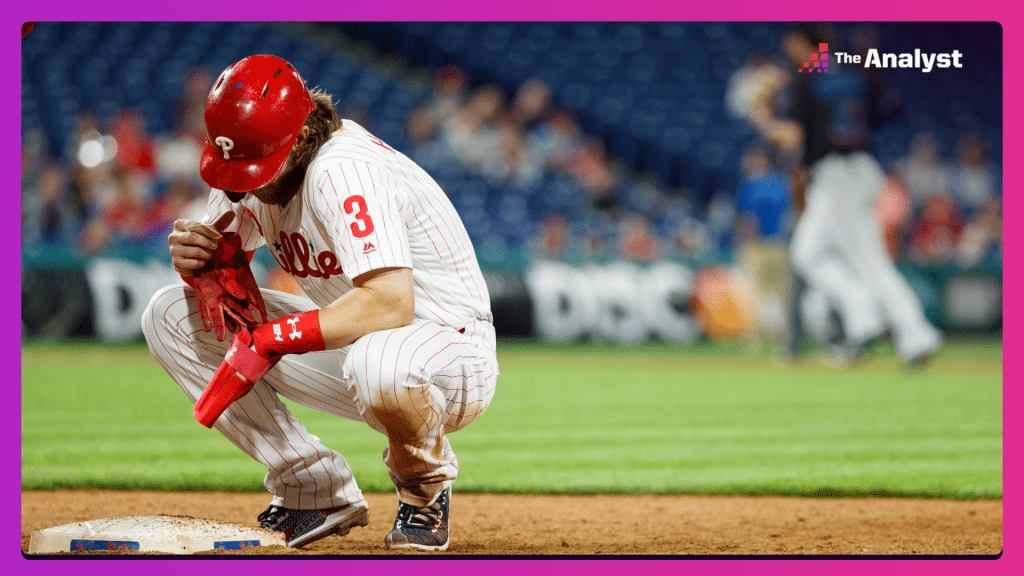
2019: Phillies – 81-81, 16.0 games back in the NL East and 8.0 out of a wild-card berth.
ROI: Basically no difference.
Padres – 70-92, 36.0 games back in the NL West and 19.0 out of a wild-card spot.
ROI: Basically no difference.
2017-18: Chicago Cubs
2017: 92-70, won the NL Central and lost 4-1 to the Dodgers in the NLCS.
Offseason: The Cubs wanted to get back to the World Series and took a leap of faith by inking Yu Darvish to a six-year, $126 million deal, and not everyone believed it was a good one after Darvish had faltered with the Dodgers in the 2017 Fall Classic. The right-hander struggled with injuries in his first season in Chicago, going 1-3 with a 4.95 ERA in just eight starts.
2018: 95-68, earned the first wild-card spot and lost 2-1 in 13 innings to the Colorado Rockies in the NL Wild-Card Game.
ROI: Worse. (We’ll explain our decision here later).
2016-17: New York Mets
2016: 87-75, lost to the San Francisco Giants in the NL Wild-Card Game.
Offseason: The Dodgers actually spent the most money that offseason, but on re-signing their own players from a team that was coming off an NLCS loss to the Cubs. The Mets were trying to get back to the World Series after falling short in 2016, so they made one of the boldest moves of an otherwise uneventful offseason by signing Yoenis Cespedes to a four-year, $110 million deal. He didn’t take the next step like New York had hoped, playing in just 81 games and hitting 17 home runs after finishing with a combined 66 in the previous two seasons.
2017: 70-92, 27.0 games back in the NL East and 17.0 out of a wild-card berth.
ROI: Considerably worse.
2015-16: Chicago Cubs and San Francisco Giants
2015: Cubs – 97-65, earned the second wild-card berth and lost 4-0 to the Mets in the NLCS.
Giants – 84-78, 8.0 games back in the NL West and 13.0 out of a wild-card spot.
Offseason: The Giants and Cubs both spent over $300 million. The Giants added Johnny Cueto (18-5, 2.79 ERA in 2016) and Jeff Samardzija (12-11, 3.81) on big contracts, while the Cubs weren’t satisfied after reaching the NLCS. No, they wanted to end the longest championship drought in pro sports. So they went out and locked up deals with Jason Heyward, Ben Zobrist and John Lackey. The rest, as they say, is history.
2016: Cubs – 103-58, won the NL Central and won the World Series 4-3 over the Cleveland Indians.
ROI: World Series champs.
Giants – 87-75, earned a wild-card berth and lost 3-1 to the Cubs in the NLDS.
ROI: From out of the playoffs to in.
2014-15: Boston Red Sox and Washington Nationals
2014: Red Sox – 71-91, 25.0 games back in the AL East and 17.0 out of a wild-card berth.
Nationals – 96-66, first in the NL East and lost 3-1 to the Giants in the NLDS.
Offseason: Losing is never an acceptable outcome in Boston. A last-place finish? Well, that’s catastrophic. So the Red Sox hoped to bounce back to prominence (they won it all in 2013) by signing Pablo Sandoval to a five-year, $95 million deal and Hanley Ramirez to a four-year, $88 million contract.
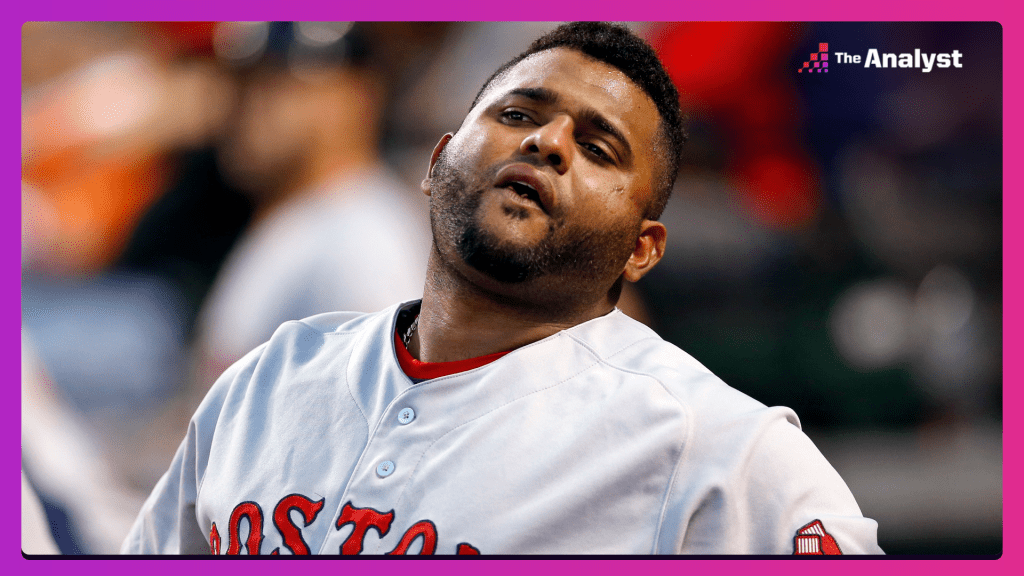
In the NL, the Cubs marked their arrivals as a serious contender by signing Jon Lester to a six-year, $155 million contract, but it was the Nationals who spent the most money. Washington was looking to push its roster over the top by adding Scherzer on a seven-year, $210 million deal. He was an All-Star, but the Nationals as a whole took a step back.
2015: Red Sox – 78-84, 15.0 games back in the AL East and 8.0 out of a wild-card berth.
ROI: Better, but still out of the postseason.
Nationals – 83-79, 7.0 games back in the NL East and 14.0 games out of a wild-card spot.
ROI: Worse.
2013-14: New York Yankees
2013: 85-77, 12.0 games back in the AL East and 6.5 out of a wild-card berth.
Offseason: The Mariners signed Robinson Cano to a 10-year, $240 megadeal, and the Yankees tried to cover up for losing their star infielder by inking Masahiro Tanaka out of Japan, Jacoby Ellsbury from the rival Red Sox, catcher Brian McCann from the Atlanta Braves and Carlos Beltran from the Cardinals. They also brought back right-hander Hiroki Kuroda. It didn’t exactly work out. Tanaka went 13-5 with a 2.77 ERA in 20 starts, Ellsbury hit .271 with 16 homers, McCann hit .232 with 23 home runs and Beltran batted .233 with 15 homers.
2014: 84-78, 12.0 games back in the AL East and 4.0 out of a wild-card berth.
ROI: Basically no difference.
2012-13: Los Angeles Angels and Los Angeles Dodgers
2012: Angels – 89-73, 5.0 games back in the AL West and 4.0 out of a wild-card spot.
Dodgers – 86-76, 8.0 games back in the NL West and 2.0 back of a wild-card berth.
Offseason: The Blue Jays re-tooled through a bunch of trades and the Angels made the biggest signing in the AL during this relatively quiet offseason by locking up Josh Hamilton to a five-year, $125 million deal. After seeing the rival Giants win their second World Series title in three years, the Dodgers responded by signing Zack Greinke to a six-year, $147 million deal that was the largest contract of the 2012-13 offseason. They also brought in Korean import Hyun Jin Ryu, who would win 28 games for the club over the next two seasons. Hamilton lasted just two disappointing seasons with the Angels.
2013: Angels – 78-84, 18.0 games back in the AL West and 13.0 out of a wild-card berth.
ROI: Worse.
Dodgers – 92-70, won the NL West and lost 4-2 to the St. Louis Cardinals in the NLCS.
ROI: From out of the playoffs to in.
The Results
Of the 13 teams we featured as the top spenders in these offseasons, only three went from out of the playoffs to qualify for the postseason and only one – the 2016 Cubs – won the World Series. And one of those clubs, the 2016 Giants, won just three more regular-season games after their big spending.
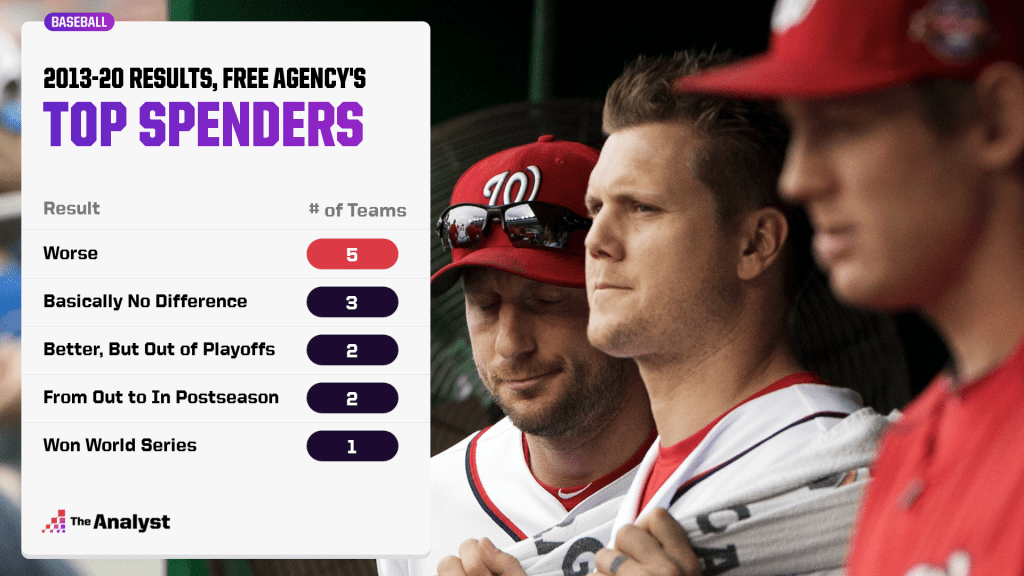
So 10 of the 13 fell into the ‘worse,’ ‘basically no difference’ or ‘better, but out of the playoffs’ categories. The category with the most teams? Worse with five.
You’re probably waiting for our explanation on the 2018 Cubs. Even though they won three more regular-season games, that Cubs team was placed in the worse category because it went from a division championship and a place in the 2017 NLCS to a second-place finish and loss in the ’18 NL Wild-Card Game. That’s a step back.
The worst of the worse may have been the 2015 Nationals, who went from a 96-win team in 2014 to 83 victories after signing Scherzer, and the 2017 Mets, who went from an 87-win club in 2016 to a 70-92 finish after inking Cespedes.
It certainly doesn’t bode well for the 2022 Rangers and Mariners.
Graphic design by Matt Sisneros.
